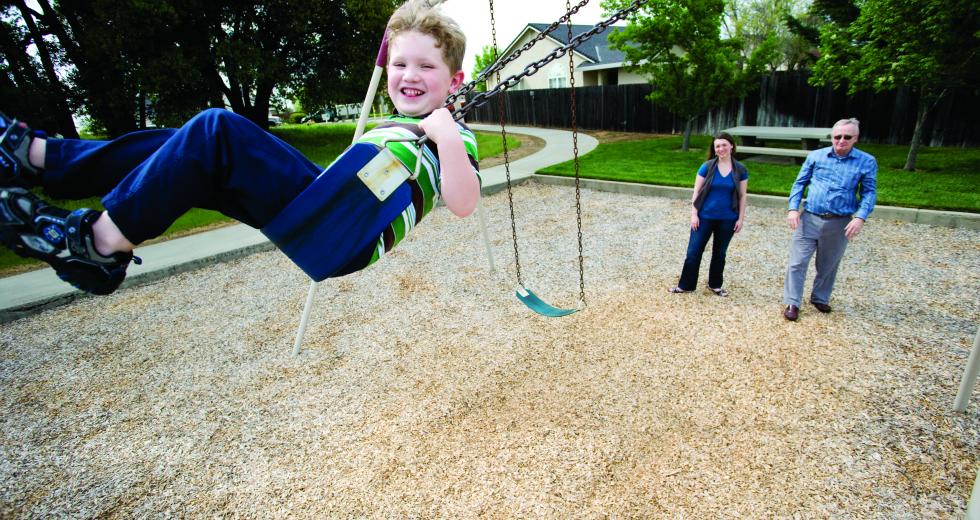Like many couples, Grass Valley residents Kendra Delaney and Rob Riley are searching for the perfect home. They’d like the house to be fewer than 10 years old, have at least three bedrooms, two bathrooms, a spacious kitchen and room for Delaney’s 6-year-old son, Sam. One other detail: The house must also be able to accommodate Delaney’s 62-year-old father, Jim Delaney.
The elder Delaney has lived with the family for more than five years, and none of them can imagine a different arrangement.
“We weren’t originally planning to all live together, but he started living with us and it’s worked out so well,” says Delaney, 32. “It may not work for everybody’s situation, but we’re all very respectful of each other’s lives and privacy.”
Although Delaney often finds herself answering questions from curious friends and co-workers about the living arrangement, recent studies indicate the family is part of a growing trend: multigenerational households. The Pew Research Center defines this type of household as one that contains at least two adult generations, or a grandparent, and at least one other generation. In 2008, a record 49 million Americans, or 16 percent of the U.S. population, lived in a multigenerational household, according to Pew.
When Coldwell Banker polled its real estate agents for a recent survey, 37 percent said buyers were increasingly shopping for homes that fit more than one generation in the past year. Financial concerns, the survey found, topped the list of reasons to combine generations in a household, followed by health concerns and strong family bonds.
Coldwell Banker’s survey was based on input from 2,360 real estate agents across the country, but local housing experts say they’re starting to see the trend in the Capital Region as well. As more people face unemployment or pay cuts, they’re looking for ways to trim housing expenses. For some, this means inviting mom, dad or their grown children to live with them to help offset the mortgage. For others, living with extended family may mean the chance to purchase a home together that they could not afford on their own. For some seniors, living with family members rather than in senior housing can be a money saver. And, in some cultures, multigenerational households are simply the norm.
“I strongly believe we’re heading down that road of more multigenerational houses in certain segments (of the market), and not every house,” says Greg Paquin of The Gregory Group, a real estate information and consulting firm in Folsom. “But clearly with the aging of the population and more people probably coming back to live with their kids and especially with ethnic diversity — some cultures are more attuned to this than others — we will see housing designed that way.”
So far, however, there doesn’t appear to be a large-scale response to this burgeoning trend. Some homebuilders have long included floor plans in their communities that appeal to those with various generations under one roof and are continuing that practice today. But in Paquin’s experience, few local developers have begun to truly respond with designs aimed directly at this market. Instead, he says, they’re simply trying to survive this economy when so few people are buying houses, whether intended for various generations or not.
But architect Jeff DeMure is promoting the design of homes that can accommodate more than one generation.
“The reason we’re introducing this is that it represents an unmet need in the market,” says DeMure, whose El Dorado Hills-based firm, Jeffrey DeMure and Associates, works primarily with merchant builders and builders in the older adult market. “In the past, 75 percent of the production home builders were building for 35 percent of the market: couples with kids. That’s an increasingly shrinking portion of the market. The low-hanging fruit is gone.”
Builders today, DeMure says, are beginning to keep multigenerational households in mind as they build new communities. They are being more thoughtful about the homes they build, better defining their target customers to include households with parents or grandchildren and incorporating these houses into typical neighborhoods, he says. This can include houses with everything from extra bedrooms to additional master suites to separate in-law units.
According to the AARP, the number of multigenerational households nationwide increased from 5 million (4.8 percent of all households) in 2000 to 6.2 million (5.3 percent of all households) in 2008. In California, 5.6 percent of all households in 2008 were multigenerational, the second-highest percentage in the country next to Hawaii.
Bill Mellerup, vice president of Sacramento-based Lewis Planned Communities, points out that multigenerational households have been around for centuries.
“Think back to the first wave of immigrants that came over,” Mellerup says. “You’ve had that situation for a long time, though it ebbs and flows a little bit. The economy drives it a little bit more, and it’s something we’re aware of as a developer.”
About a decade ago, the company began noticing that an increasing number of buyers were not the stereotypical mom, dad and two-children households, Mellerup says. Instead, they were mom, dad, children, plus an extended network of relatives. That’s when the company consciously began trying to capture more of that marketplace by designing some of its homes with multigenerational needs in mind.
“We’re going to have a pretty wide palette of homes available, and the consumer has the ability to choose from that palette,” Mellerup says. “Within that palette of five or six homes, one or two are going to be geared toward multigenerational households.”
That has meant designing some houses with more bedrooms and separating those bedrooms into different areas of the house to give occupants more of a sense of privacy, Mellerup says. Communal areas might be a little larger to accommodate the increased number of residents in the home. The result of those changes has been an increase in home size to some degree. While that in turn pushes the price upward, more people in a house often means a greater ability to pay a bigger price tag.
In 2008, a record 49 million Americans, or 16 percent of the U.S. population, lived in a multigenerational household.
Still, Mellerup says he hasn’t noticed any real increase in the number of people seeking multigenerational houses in Lewis’ communities in recent months. That’s not because they’re not out there, but rather it is a reflection on today’s marketplace. The overall number of buyers is so low compared with a normalized market that it’s difficult to differentiate multigenerational house seekers from others, he says.
Pulte Homes’ experience with the multigenerational market has been similar. For the past 10 to 15 years, the homebuilder has offered floor plans that include a second master suite downstairs, which many homeowners have used to house aging parents, says Christopher Cady, president of the Sacramento/Reno division of Pulte. With such a setup, those living in the downstairs master suite have their own sense of privacy — some floor plans have even included a separate entrance — and don’t have to worry about navigating stairs.
“Even in a lot of our traditional communities and floor plans, the master suite downstairs was utilized for that very reason,” Cady says.
Pulte hasn’t come up with any recent designs relating to multigenerational needs, although Cady says it might in the future. The challenge is dealing with what is already planned and built while trying to anticipate tomorrow’s demand when the economy turns around. That said, multigenerational housing is among the housing trends the company is researching as it plans for the future, he says.
Pulte learned how important that type of housing is to some buyers as it began building on smaller lot sizes over the past five to seven years and as a result had to forgo the downstairs master suite in some communities, Cady says. Consumers objected: They wanted that downstairs suite. The company is now examining how to include the suite even in houses on smaller lots, trying to determine what buyers would be willing to trade in a floor plan in order to have such an amenity included.
Kevin Coates, president of Sacramento-based The Advantage Group, a new home sales and marketing company, says there is a growing realization among builders that homes that fit multigenerational needs can still fit within the trend of building houses with a smaller square footage. It is simply a matter of rethinking what absolutely needs to be included in a house and where.
Would an additional bedroom be preferable to having a formal living room? Rather than having bedrooms grouped together, could they be split up into different parts of the house to provide more privacy?
“(A house) doesn’t have to be 3,000 square feet to mean that grandma or grandpa can live with me,” Coates says.
In the resale market, real estate agents are seeing more buyers who recognize that a house doesn’t have to be large in order to accommodate different generations. For them, it’s more about the right floor plan than the size. That varies from buyer to buyer, but it could mean a second master suite, a lower level bonus room with its own entrance, an in-law unit on the property, or simply room enough to build one.
“(Buyers) want some space where grandma or grandpa can have a little privacy away from the family,” says Diann Patton, a broker with Coldwell Banker Grass Roots Realty in Grass Valley.
Just in the past few months, agents with her brokerage have seen an increase in the number of buyers looking for houses that can accommodate multiple generations. One woman, for example, pooled her resources with her mother to purchase a house that had an in-law unit for her mother’s full-time caregiver rather than have her mother in a health care facility. The increasing frequency of such examples has led Patton’s agents to begin suggesting that sellers emphasize any multigenerational features of their homes.
Delaney and Riley, the Grass Valley couple who have had a multigenerational household for years, are among the buyers with which Patton’s firm is working. Although they are buying the house on their own (though Delaney’s father may help out with expenses as he does now), they know that when they find something they like, it must meet the needs of all members of their household.
“If we found a place that we were really interested in, we’d bring (my father) along,” Delaney says. “He would definitely come along to take a look and make sure it would work for him as well.”
Recommended For You

Family Values
Negotiating your personal worth as a caregiver
When Shelley Tabar’s father fell off her roof, she became his primary caregiver and subsequently lost nearly half her income.



